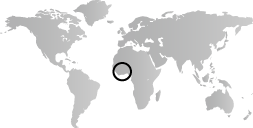During this period, Ife (also known as Ile-Ife), the cradle of contemporary Yoruba culture, is the center of some of the richest artistic traditions of the Guinea Coast. Situated in the West African forest, Ife is the center of a trading network that capitalizes on its accessibility from the Niger and several smaller rivers, from the West African coast, and from the savanna country to the north. Stone monoliths are characteristic of early Ife art, while in the latter half of the first millennium A.D., distinct styles of finely modeled terracotta representations and works in cast metal are developed and refined. This period is also significant for the emergence of lost-wax casting. While the smelting of metallic ores dates to the first millennium B.C., and by about 1000 A.D. iron and copper smelting techniques have spread throughout the continent, the complex technique of lost-wax casting begins to be practiced only in the tenth century. This method of producing exquisitely refined brass works is first employed along the Guinea coast at Igbo-Ukwu, a region populated by Igbo peoples.
Guinea Coast, 500–1000 A.D.
Timeline
500 A.D.
625 A.D.
625 A.D.
750 A.D.
750 A.D.
875 A.D.
875 A.D.
1000 A.D.
Overview
Key Events
-
ca. ?–800
Ife, in present-day southwestern Nigeria, becomes an important urban center. Its origins can be traced back to around 350 B.C., when it began as a cluster of some thirteen hamlets. Sedentary agriculture is practiced in this early, Archaic period of Ife’s development. Powerful abstract stone monoliths—their forms resembling staffs, swords, and phalli—are often combined with iron, suggesting a transition from Neolithic to Iron Age technology.
-
ca. 800–1000
During what is known as Ife’s Pre-Pavement period, human and animal figures in stone and terracotta become more common, and are depicted with increasing naturalism.
-
ca. 10th century
Artisans of Igbo-Ukwu, in present-day southeastern Nigeria, produce meticulously detailed copper-alloy objects, many decorated with tiny spirals and images of insects. These objects reflect a true mastery of lost-wax casting. The presence of copper, which is not indigenous to the region, as well as other goods such as glass beads, suggests a connection to long-distance trading networks of the savanna and the Sahel. The practice of lost-wax casting this far south may indicate a link with the Inland Niger Delta, where the process is well known at this time. Three sites have been excavated at Igbo-Ukwu, including a storehouse filled with prestige objects, a pit, and an elaborate burial in which an important personage was ceremonially entombed. Scholars believe that this person, buried with an elephant tusk at his feet, may have been a ritual leader, possibly similar in certain respects to more recent local practitioners.
Citation
“Guinea Coast, 500–1000 A.D.” In Heilbrunn Timeline of Art History. New York: The Metropolitan Museum of Art, 2000–. http://www.metmuseum.org/toah/ht/?period=06®ion=afg (October 2001)
